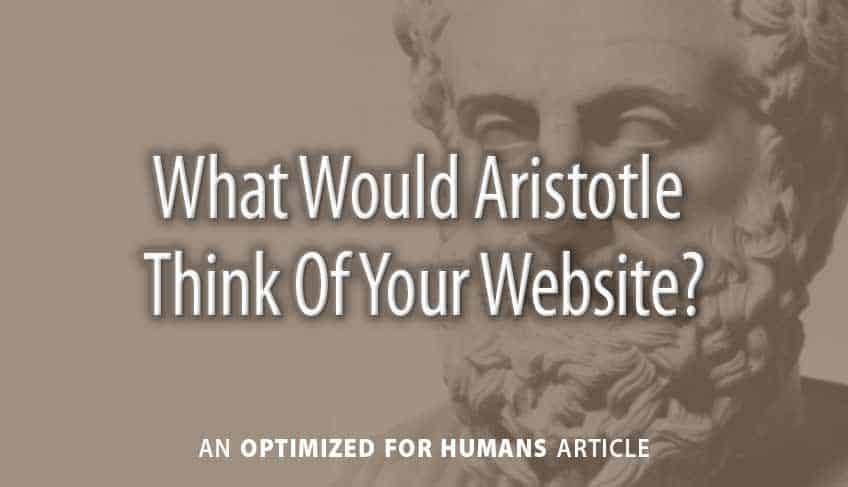
B Y T O M T O R T O R I C I
Back in ancient Greece, Aristotle offered his students some smart tips about how to persuade their fellow humans.
If your modern business website happens to includes his three modes of Classical Rhetoric to help convert your visitors, the ancient philosopher would surely approve. And perhaps be impressed with himself at the millennium-spanning durability of his lessons.
Classical Rhetoric is all about persuasion, and bringing people around to a certain way of thinking. It’s been an enduring component of everything from academic debates to political speech to, yes, convincing folks to pony up cash for our products and services.
So what are those three rhetorical approaches? They’re called Ethos, Logos, and Pathos. Are you already using them on your website? Let’s see.
Ethos: The trust factor
This issue, as applied to our contemporary world of commerce, concerns whether a particular online seller of wares is ethical, or trustworthy. Nobody buys from a vendor they don’t trust, right?
You’ve seen sites with appeals like, “the company you can trust.” But coming from the company itself, that’s a pretty superficial and ineffective application of the principle.
That’s why we include what we now call ‘social proof’ on our sites. Enthusiastic testimonials, a list of well-known clients, four-and-a-half star rankings, and Social counters all stand as independent (and hopefully positive) assessments of the quality of our products and the ease of acquiring them.
A blog full of genuinely helpful insights and information can also help elicit trust, because you’re offering folks something valuable before asking for anything in return.
Logos: The logic factor
No, we’re not talking about graphic brand identity here. This is about whether the arguments in favor of your product really make sense.
Plenty of sites make vague promises and claims, and we’ve learned to tune those out. So, simply signing up for your company’s sales training course will make me wildly rich and successful? Really?
Smarter marketers take their readers step-by-step, making logical arguments that lead the buyer to a logical conclusion about the real-world benefits of the product or service offered. The sequence might go something like this: an acknowledgement of person’s goal > the obstacle that’s keeping them from that goal > the type of solution that would overcome that obstacle > the company’s unique specialization in just that type of solution.
For the logic angle to work, we need to start with a deep of understanding the prospect’s predicament, how they see their options, and the other real-world factors that affect their decision.
Pathos: The emotion factor
If you look closely enough, you’ll realize that just about every buying decision has an emotional component. Surprisingly, that’s true even in most B2B buying scenarios.
We are emotional creatures, and while logic is important, it’s often not enough to seal the deal. That’s why a purely technical explanation of a product can make our eyes glaze over, with our money remaining in our pocket.
Apple’s Think Different campaign didn’t talk about hardware features and benefits – it simply made Apple buyers feel special in their own unique approach to the world. The cosmetic company L’Oreal once fed us the line, “It costs a little more … but I’m worth it.” Wow. They started charging more than their competitors, and were still outselling them. That’s what a truly sensitive and insightful appeal to emotion can do.
Again, this can only work if we drill deeper into mindset of the people buying the product, vs. the mindset of the people selling it.
Take advantage of an old Greek guy.
Well, maybe modern online marketers use Aristotle’s principles of Classical Rhetoric in slightly different ways than he originally intended. But he’s been dead for quite a while, so no harm done.
Trust. Logic. Emotion. They’re just three little words, but skillfully applying those lessons can motivate people to move mountains for you.
Sure, you might have your own way of selling on your company’s website. But will people still be talking about your approach in a couple of thousand years?
Get In Touch. And together, let’s persuade the heck out of those nice humans who land on your site.
Share It:
 About the Author: Tom Tortorici is an Atlanta copywriter and web content writer who helps companies make a genuine connection with their audience. His classes and conference presentations have focused on how writing, strategy and design can work together to grab attention and interest even among readers with short attention spans. In addition to working directly with businesses, Tom regularly partners with web designers and marketing agencies.
About the Author: Tom Tortorici is an Atlanta copywriter and web content writer who helps companies make a genuine connection with their audience. His classes and conference presentations have focused on how writing, strategy and design can work together to grab attention and interest even among readers with short attention spans. In addition to working directly with businesses, Tom regularly partners with web designers and marketing agencies.
All Posts/Subscribe >
Info for Businesses >
Info for Designers/Agencies >
Tom Tortorici Inc. | Tom@TomTortorici.com | 770-934-7861 | 3101 Rockaway Rd | Atlanta GA 30341
